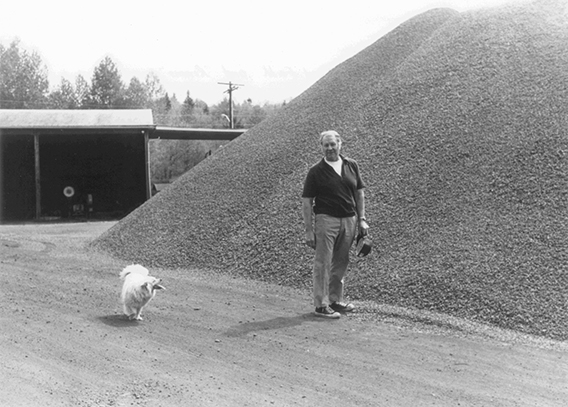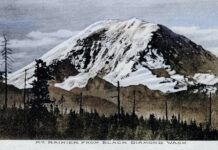One of the more interesting legacies of coal mining in South King County were the stockpiles of coal slag that burned for decades and created a landscape product called red cinders. The story began in the 1880s when miners found rich seams of the black-colored ‘diamonds’ that gave the area’s first coal mining town its name––Black Diamond.
The early miners sought only the purest coal of the highest quality, discarding the mined residue called slag consisting of low-quality coal, shale, sandstone, and clay. At surface facilities, dozens of outside workers labored on picking tables separating the best coal from waste slag disposed into large piles adjacent to the mine portal.
Through spontaneous combustion, the waste piles caught fire and smoldered for years at extreme temperatures sometimes approaching 1,500º Fahrenheit. The intense heat from burning coal fused the shale, sandstone, and clay together while iron pyrites from the famous McKay coal seam caused the blazing slag to turn red. The stockpile acted as a giant oven often compared to the brick-making process, so red cinders were referred to as ‘nature’s brick.’ In other parts of the country, cinders of different colors are known as scoria, clinkers, or ash.
The first use of red cinders was constructing travelways such as the Black Diamond-Ravensdale Road, in early years called the ‘red-top road.’ In time cinders became popular for surfacing high school running tracks and later for driveways, flower beds, and general landscaping. In 1969, a Kirkland firm, Vaux Construction Company trademarked the product as Cintrex. When the Seattle Mariners’ Safeco Field opened on July 15, 1999, its outfield warning tracks were a mix of red cinders and ground lava rock. The product was known as Safeco Warning Track Mix but was later replaced at the stadium by a different material.
Over the years almost all of Black Diamond’s red cinders were sold with estimates of the quantity marketed since the 1950s at over one million cubic yards. The last remnant of that once huge stockpile marketed by Palmer Coking Coal Company is down to the final several thousand cubic yards.
This 1977 photo features Carl Falk, manager of Palmer Coking Coal standing beside a 3/4” red cinder stockpile and joined by the company’s dog named Rennie. Carl Gustav Falk was born in 1920 and emigrated from Sweden with his family at age seven. He grew up in Enumclaw and following graduation, attended the University of Washington on a full-ride scholarship, playing tackle for the Husky football team.
Charlie Falk, as he was known married his high school sweetheart, Betty Morris in 1942, and then started work at Boeing building B-17 airplanes for the war effort. A couple years after World War II, Falk joined Palmer Coking Coal where he utilized the engineering skills he studied at college. Falk eventually became the company’s office manager and in 1977 ascended to the firm’s top position as Operating Manager, serving in that capacity until 1981. Carl Falk passed away at his Renton home in 1997 at age 77, but not before teaching the author of this column a great deal about the history of coal mining in King County.







